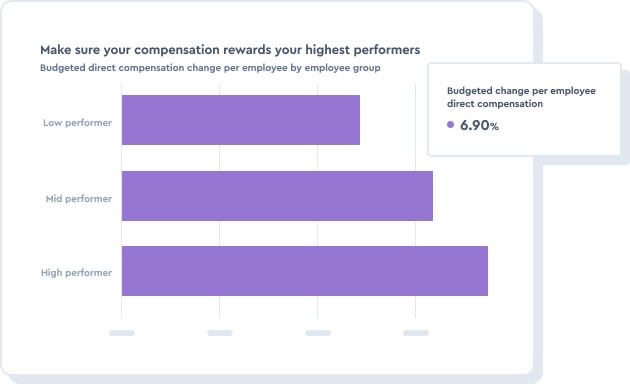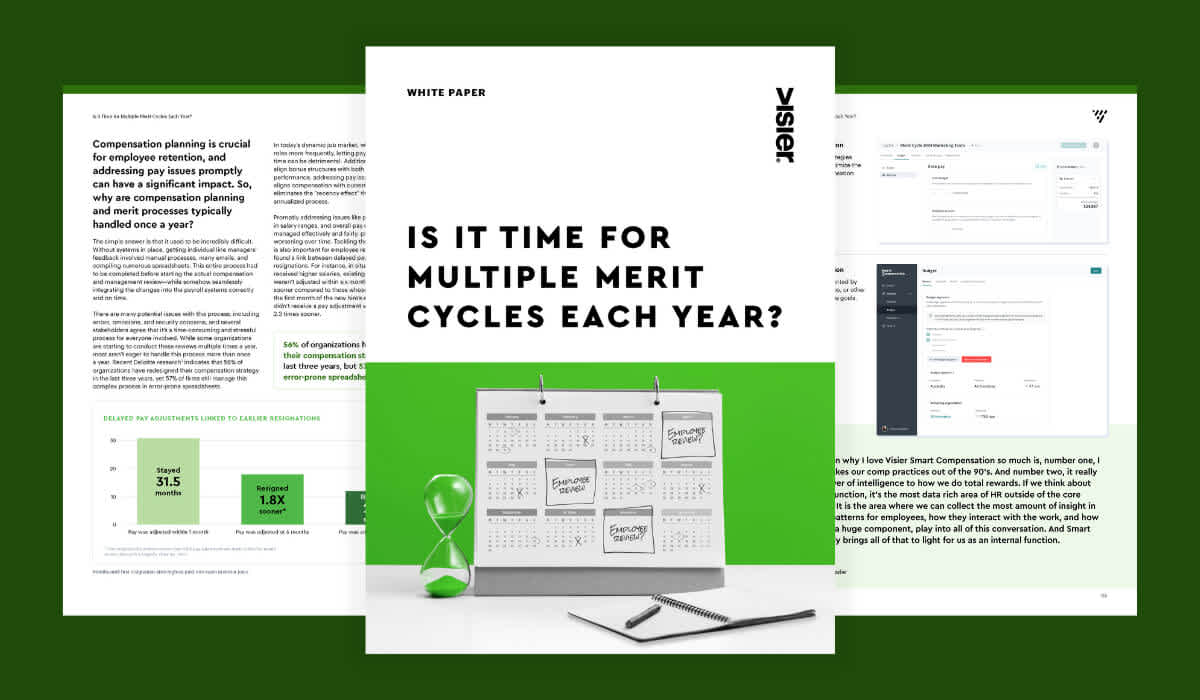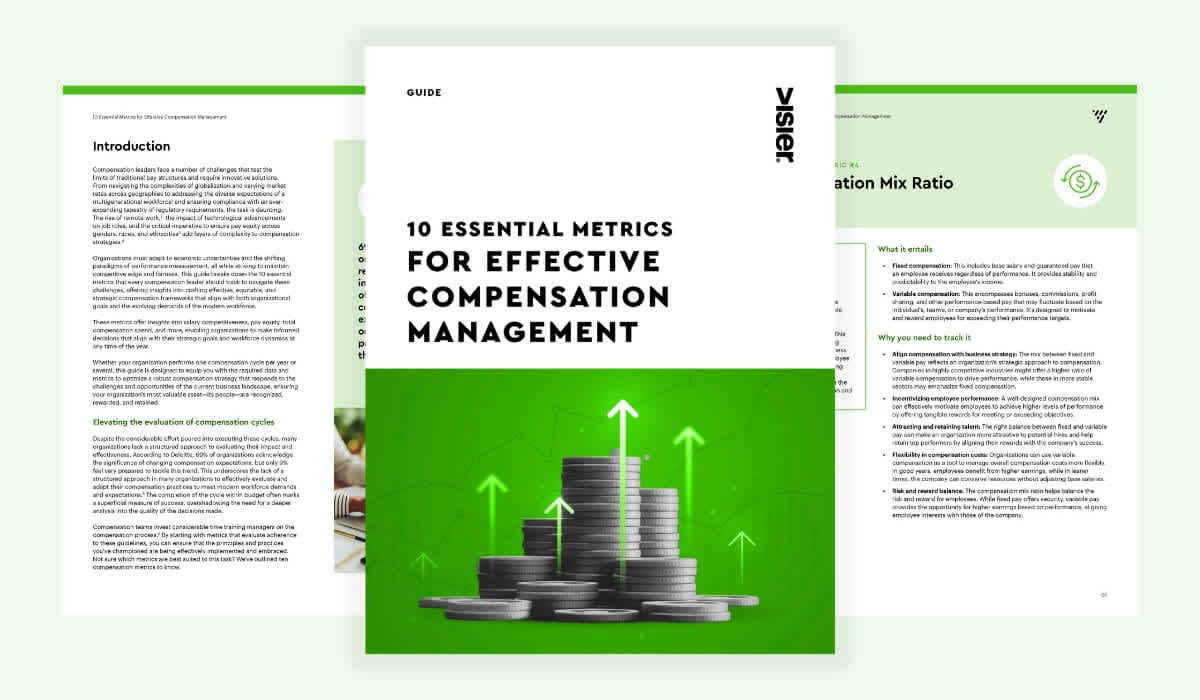What is a Merit Increase and Why Does it Matter?
Merit increases are different from other types of pay raises. Learn what defines a merit increase, how to determine merit increase amounts, and when to use these pay increases.

With so many types of increases to your salary, how do you know which is which? We’re talking about merit increases, cost of living adjustments, performance bonuses, and a plain old raise. However your pay moves up the scale, it’s important to understand how these salary adjustments are determined. In this article, we dive into the world of merit increases and how people data and analytics makes it easier to make salary decisions.
What is a merit increase? Know the difference in types of pay raises
A merit increase is a pay raise given to an employee based on their performance. This is often used as an incentive to motivate employees in the workplace by recognizing their hard work. When implemented well, a merit increase can also be used as a retention, productivity, and performance management tool.

Merit increase vs. pay raise
Put simply, the difference between a merit increase and a pay raise lies in the criteria. A merit increase is a boost in pay as a result of excellent work, while a pay raise isn’t necessarily related to the quality of work. A merit increase is a type of pay raise that is given based on how employees perform at work. It is often used to reward the top-performing employees within the company. As a result, this can encourage employees to achieve company goals while relating their efforts and goals to the increase in their salary.
For example, say Joanna is a top-performing employee for an organization, and she was able to successfully achieve and exceed the company’s goals by 5% for that year. Hence, she would be able to see her effort reflected in the merit increase in her salary. In comparison, Ashley in the same organization would only be receiving her normal salary as she was unable to achieve or exceed the company goals that year.
A pay raise is an increase in an employee’s salary that is not associated with their performance at work. Therefore, a pay raise would often be an increase in salary that is generally spread across the board. So, if Joanna and Ashley have the same job title and are working for the same organization, when it comes to the organization’s annual pay raise, both of them will likely receive a similar increase in their salary.
Does a merit increase include the cost of living?
A cost of living adjustment (COLAs) is a salary boost to reflect the increase in the cost of consumer goods and services that is purchased by a typical person. This type of increase could be a one-time amount or an overall increase to an employee’s annual salary.
It can be difficult to know when COLAs and merit increases fit into the equation, as they're irrelevant to the two forces that drive salary increases: market price and internal value. However, COLAs do affect your salary as it is a type of pay raise to reflect inflation in the costs of goods and services. Therefore, this will affect the employee’s salary increase in the long run.
For instance, if annual inflation increases by 2%, it may be wise to also increase your employees’ salaries by 2% so they can still support their basic living costs. Perhaps an employee moves to a new city with a higher cost of living, then you might consider an adjustment to match the market price of what the employee is worth if they were hired by another company in the new city. COLAs are a great way to prevent employee turnover.
Cost of living adjustment vs. merit increase
If an employee moves to a new city to work, consider using the cost of living adjustment to modify the employee’s salary to account for the increase in basic living expenses.
On the other hand, if the employee is performing extremely well, such as exceeding your organization’s goals, you might consider providing a merit increase to the high-performing employee as a reward for their efforts.
If the employee moves to a new city and also outperforms business goals, consider providing both the cost of living adjustment and merit increase to the employee’s salary.

How much is a standard merit increase?
Your boss says you received a pay bump for your good work in the amount of 3%—is 3% a good merit increase amount? What about 5%? The amount of a merit increase can vary widely based on the company giving it and the employee receiving it. It is standard for companies that take good care of their employees to award top performers with an increase in the neighborhood of 3% to 5% on an annual basis.
Mercer's latest QuickPulse U.S. Compensation Planning Survey found the average merit increase for 2024 is 3.3%, with total increases averaging 3.6% across over 1,000 surveyed organizations.
These merit increases should be independent of pay raises to adjust for inflation or raises that would occur if the market of a particular role were to change significantly or the demand for the job type increased.
Is a merit increase the same as a promotion?
Not necessarily. A promotion generally means that an employee is given a new title and new responsibilities within the organization—and that promotion may not come with a salary increase. A promotion could certainly be in order as a recognition of merit because of hard work, or going above and beyond. Merit increases don't always come with a promotion.
Why do merit increases matter?
Merit increases are a way to show employees appreciation and recognition of a job well done. Studies show that employees who feel appreciated perform better and are less likely to quit their jobs. Rewarding mediocre performance can lead to mediocre results, which can also impact employee morale. As the former Chief Talent Officer for Netflix wrote in this Harvard Business Review piece, when it comes to employee engagement, excellent colleagues “trump everything else.”
Salary increases can also encourage hard-to-find star performers to stay with the company longer. New research about pay and compensation trends found the compensation sweet spot for retaining employees lies between the midpoint and 120% of the compensation ratio.
How to calculate merit increases
When a top performer leaves the company, the indirect costs in the form of lost client relationships or stifled product innovation can be staggering. Consulting firm Bain & Company has estimated that, across all job types, “the best performers are roughly four times as productive as average performers.” According to HR thought leader Dr. John Sullivan, at a high-performing technology organization, “a single top-performing programmer would produce an astounding $48 million per year in added value each and every year.”
It’s not surprising, then, that many organizations are adopting pay-for-performance cultures when it comes to merit increases. But some experts have argued that pay differentiation should be the exception and not the rule. It can be difficult to determine the impacts of differentiation with sufficient precision, reliability, and accuracy. If employee retention is the primary goal, it's important to assess factors beyond compensation that can increase the resignations of top performers in critical roles, too.
By combining people analytics with compensation planning, you can actually dedicate budget in the merit cycle to retain key talent in critical roles in your organization and empower people managers to make strategic, informed merit decisions for their team.
How to use people analytics to determine merit increases
Follow these steps to model different merit increase configurations and make the right decision for your company:
Determine if an employee’s performance financially impacts the business
Objectively assess performance
Determine whether merit increases will work
Model out the increases

Step 1: Determine if an employee’s performance financially impacts the business.
It is important to define how performance in different job types contributes to business performance. This will help determine what exactly constitutes a reasonable differential.
For example, the Bain & Company research suggests that, for roles involving repetitive, transactional tasks, top performers are typically two or three times as productive as lesser performers. The differential is likely to be a factor of six or more in highly specialized or creative work.
Another fundamental task is to determine what, exactly, is a critical role. To do this, ask these questions:
What is the cost of mistakes in this role?
How difficult is it to replace someone in this role?
How closely is this role tied to the success of our business strategy?
This does not mean you should rush out and, say, give an increase that is six times greater to all those people in a creative, critical role. It may not be sustainable for your business from a budget or employee morale perspective, and may not even be necessary. This is where segmentation and scenario modeling are helpful.

Look at the budgeted direct compensation changes to ensure your compensation plan rewards your highest performers.
Step 2: Objectively assess employee performance
Once you have defined who is in the business-critical roles, it is time to find those individuals who are really moving the needle in terms of performance. To objectively determine who is a top performer, look beyond performance reviews. Humans use heuristics to make snap judgments about other people. A salesperson’s recent fumble, for example, can overshadow a history of consistently strong performance.
To make a valid assessment of performance, gather data from multiple sources. Performance ratings need to be combined with other data like potential rating, tenure, and recognition awards to get a full, unbiased view of how the person is performing. Job-specific data, such as units produced or number of sales deals made, can also be considered.
This is where a people strategy platform that brings employee, performance, financial, and business data together can be a big help. Without information from multiple sources, assessing who stands out from the pack can be prone to bias.
Step 3. Determine whether merit increases will work
Now you need to answer a big question that many compensation teams forget to ask: whether merit increases will actually drive retention.
While compensation is consistently a retention factor, there are many other reasons why people quit, from job security and poor onboarding to workplace stress and location. Micron found that a tweak in job descriptions helped address an issue with resignations due to job fit. So it pays to investigate the problem first before designing a solution.
Predicting flight risk can involve some pretty sophisticated technology and techniques, but it’s about building a profile of people who left in the past, which can then be used to identify similar characteristics in existing employees.
Advanced “in-memory” applications make it easier to run tailored algorithms to help identify flight risk. This has been proven by data scientists to be up to 17 times more accurate than other methods.
Step 4. Model out the pay increases
Once you have confirmed that salary increases will help retain a certain group of high performers, model out different increase scenarios to determine how they will impact your organization. The goal is to retain the highest number of people at the lowest cost.
Start with three pay-increase scenarios:
Scenario 1: In this baseline scenario, everyone gets the same amount—a 3% increase.
Scenario 2: Here, the differential is greater—an increase in 5% for top performers and 2% for everyone else.
Scenario 3: In this scenario, only critical roles within the top talent segment would be given a 5% increase while everyone else would receive 2%. Alternatively, a 5% increase could be assigned to all critical roles, regardless of performance
As you review each scenario, consider other factors such as time-to-fill. A bigger differential may be required if the roles are critical and the talent required to fill them is scarce. If the battle for these people in the market is less fierce, you can likely get away with a smaller differential. You can go back and keep refining the scenarios until you have developed the best plan.

Merit pay differentiation finally becomes a reality
Merit pay differentiation used to be a good idea in theory. Now, with advances in analytics technology, it is also a good idea in practice. With a holistic approach to your people and business data gathered instantly from multiple systems, you can gain the insights you need to reward performance and keep star players.
Merit increase FAQs
What is the difference between a raise and a merit raise?
A merit increase is a type of pay raise given to an employee based on their performance. A pay raise is an increase to the employee's base pay, and isn't necessarily tied to performance.
How much is a merit increase usually?
The merit increase amount is typically a percentage and is often linked to company goals and objectives. According to Mercer, the average annual merit increase budget for 2024 is 3.3%.
Learn more about merit increases and smart compensation



